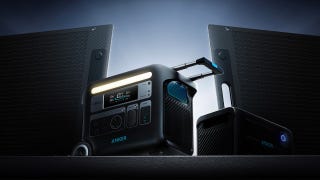
<aRivian and Amazon's Electric Delivery Van Is a Big Box With a Seriously Clever Design


Naturally, the IIHS doesn’t drive vehicles into concrete pylons under their own power. The agency uses a propulsion system consisting of a tow cable that gets hooked to the vehicle and brings it to a speed of 40 mph over just 600 feet. This battery of tests with extra-heavy vehicles was meant to ensure the 20-year-old “crash machine” is up to the task with increasingly massive vehicles.
Advertisement
Since the IIHS only needed to test the strength of the system, the agency didn’t need to consume a real and extremely expensive EV. Instead, they loaded up some older model vehicles and slammed them into the concrete. The 9,500-pound test vehicles represents the heaviest automobiles IIHS has ever smashed in its testing facility, knocking the sub-6,000 pound 2019 Audi E-Tron out of first place.
Crashing EVs can be a risky business. Joe Young, Media Relations Director at IIHS, told Jalopnik there are special considerations when crash-testing a battery-powered vehicle.
G/O Media may get a commission

50% Off Trial
Nom Nom
Good, whole food for your dog.
Nom Nom’s meals are overseen by two Board-Certified Veterinary Nutritionists, who make it their mission to deliver your dog nutrient-rich, healthy foods.
Advertisement
“We do test with the batteries in place (at a charge of about 12.5 percent), and we closely monitor the battery temperature during and after the crash,” Young said. “We also have some special precautions in place to ensure that the vehicle chassis is not electrified before our technicians start doing post-crash analysis. And there are special precautions in place to move the vehicle outside quickly and safely if there were a problem.” So far, IIHS has never had an EV catch fire during crash testing, but it pays to be prepared, because battery fires are no joke.
Heavy electric cars, however, are likely to make a bad problem on U.S. roads even worse. Not to be a broken record, but traffic deaths reached a 16-year high in 2021 and this year is not looking much better. Part of the reason for this higher fatality rate, especially among pedestrians, is the increasing presence of heavy, large SUVs and trucks on the roads. The IIHS’ own studies show that such vehicles are more likely to kill pedestrians and other vulnerable road users. It seems another way we could easily cut down on traffic deaths would be to restrict the size and weight of mainstream vehicles, but considering automakers make bank on such vehicles, that solution is likely a non-starter.
Alaska Airlines introduces digital bag tag program “The last point our visitors intend to do is stand in line,”stated Charu Jain, elderly vice-president of retailing and advancement for Alaska.”With the addition of the Alaska Airlines electronic bag tag, our guests can finish almost all of their check-in tasks– from the convenience of their house, at the workplace or on the way to catching their flight.” Advertisement Alaska estimates that the digital bag tag system will certainly cut the time that passengers spend in airport terminal lobbies by 40 percent. The airline likewise claims that the BAGTAG tools don’t need to be billed or fitted with a replacement battery. Supposedly, Alaska workers tested the device’s durability by running it over with a truck. Alaska Airlines’ digital bag tag gadgets will certainly be offered for purchase in 2023 and will deal with all Alaska Airlines marketed flights run by Alaska Airlines, Horizon Air and also SkyWest Airlines. The list price has yet to be disclosed however is estimated to be around$70 based on the price of the conventional BAGTAG device. While the convenience supplied is extremely appealing, I’m a bit doubtful, specifically if Alaska would certainly be the only provider I can use the electronic bag tag with. If all the significant U.S. airlines made use of the system, I wouldn’t wait to get one as a relatively regular leaflet.

For GREAT deals on a new or used Chevrolet check out Tom Gibbs Chevrolet TODAY!
Honda cites Japan’s aging population, declining birthrate and the global pandemic as a few of the reasons why it sees the need for small self-driving EV and AVs, which people can hail and even depend on for basic transportation.
Advertisement
Honda recently started testing out its micro-mobility device at public parks in Japan, where the automaker says automotive AI has difficulty traveling over unclear roads and paths. The four-passenger model being tested is one of the larger AV models, known as CiKoMa, but Honda plans to make single and multiple passenger versions of these micro cars by 2030. Well, “devices” would be more appropriate since people won’t drive these in the traditional sense.
Riders will simply call on CiKoMa, and wait as the car drives itself to the rider using a suite of AI hardware, including camera arrays that eliminate the need for high-definition maps. CiKoMa will not rely on maps or servers that transmit remote data; the tiny robot car will rely on sensors to produce local data that’s immediately and constantly analyzed to help it “decide” a route and even make suggestions. It’s closer to what many would consider a true self-driving car; the big difference is that Honda’s tiny machines are not easily recognizable as cars.
G/O Media may get a commission

$400 off
Anker 767 PowerHouse
Powered by GaNPrime
Anker is launching a new power station in its lineup—the Anker 767 PowerHouse. It delivers a massive amount of power at 2400W and has a suitcase design for easy portability.
Advertisement
In their current state, Honda’s micro AVs look more like golf carts or UTVs. But Honda thinks these machines have a place in cities and urban environments of the future. Golf carts have proven useful in certain settings outside of the golf course — even in the U.S., where small cars are becoming less and less popular.
Advertisement
Indeed, driving (or being driven in) a golf cart among large vehicles on public roads looks like a disaster waiting to happen. But Honda says this is what mobility for all looks like: a mixture of EVs and AVs driven by people who are still interested and capable of driving themselves, in, say, a Honda e, and a lineup of micro-mobility devices be capable of recognizing riders and users through sight and biometrics.
Honda says CiKoMa and WaPOCHI will even be capable of having “human-like” exchanges. It’s unclear if Honda can develop these devices in eight short years, but, at least, it’s good to know that the spirit of ASIMO lives on in these robots.
Advertisement
Advertisement